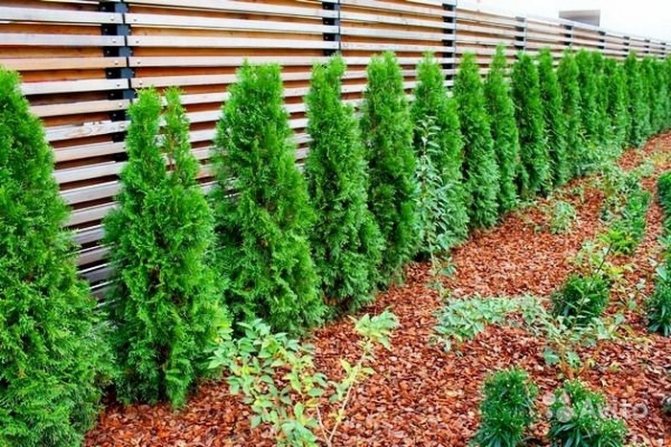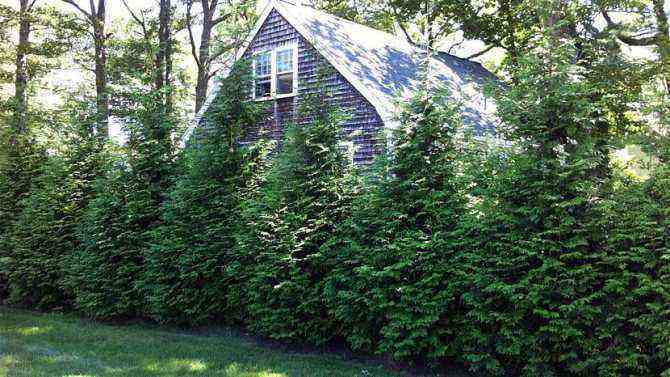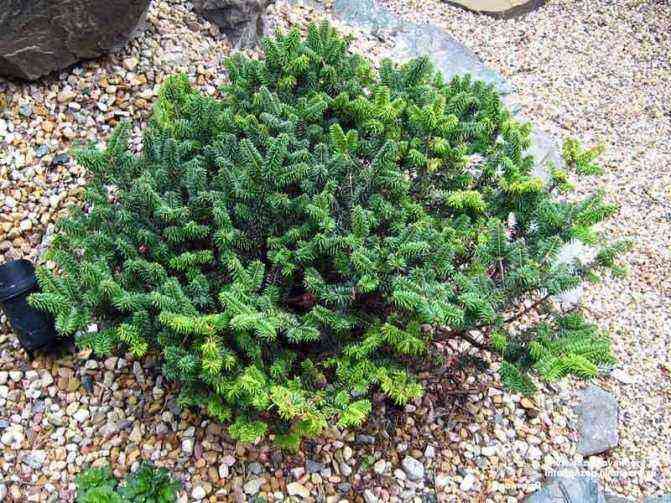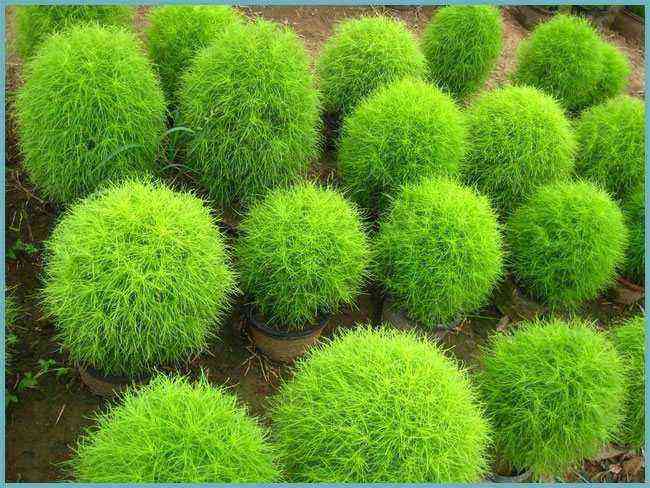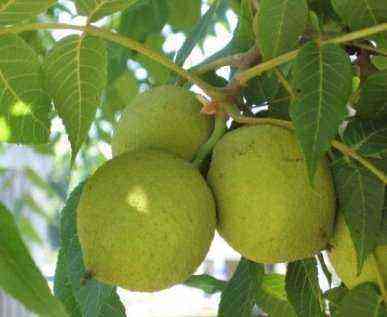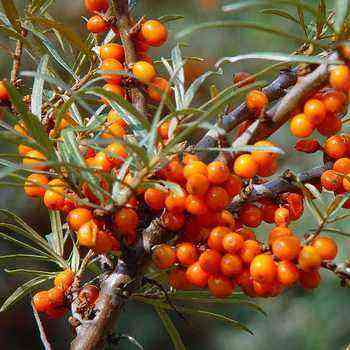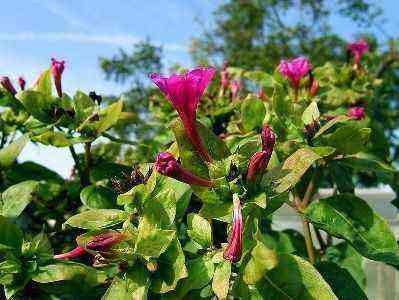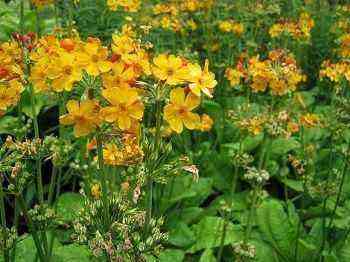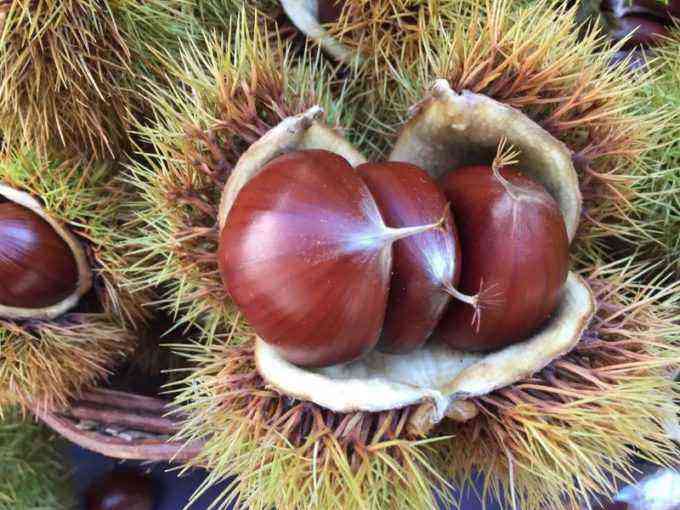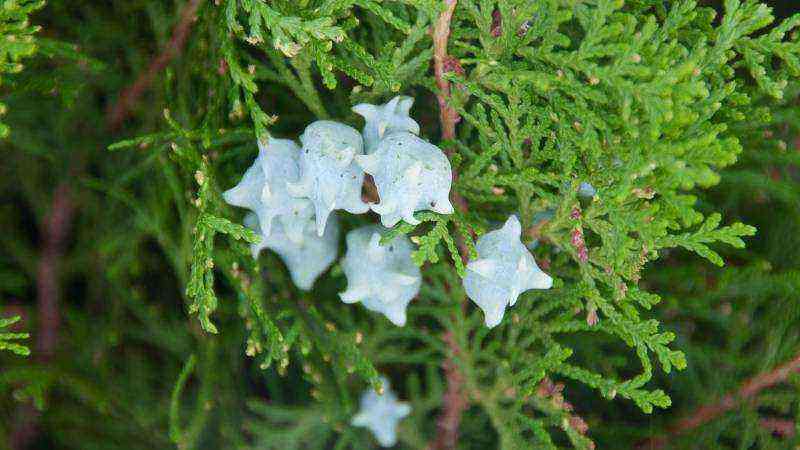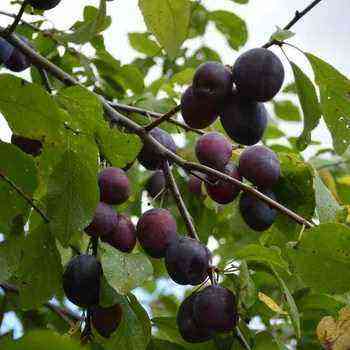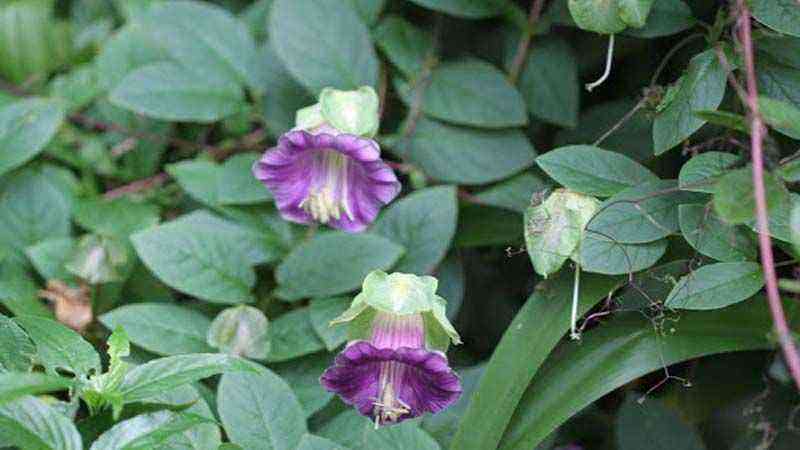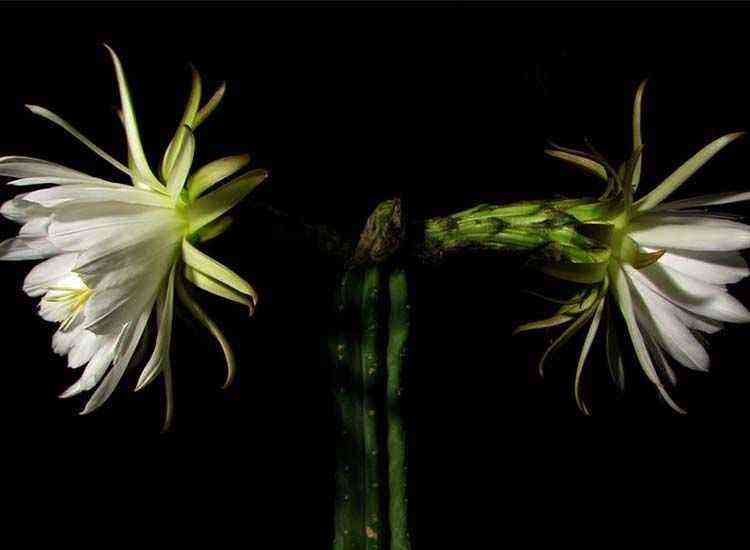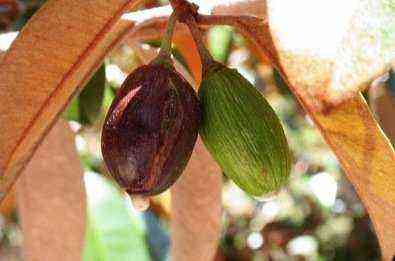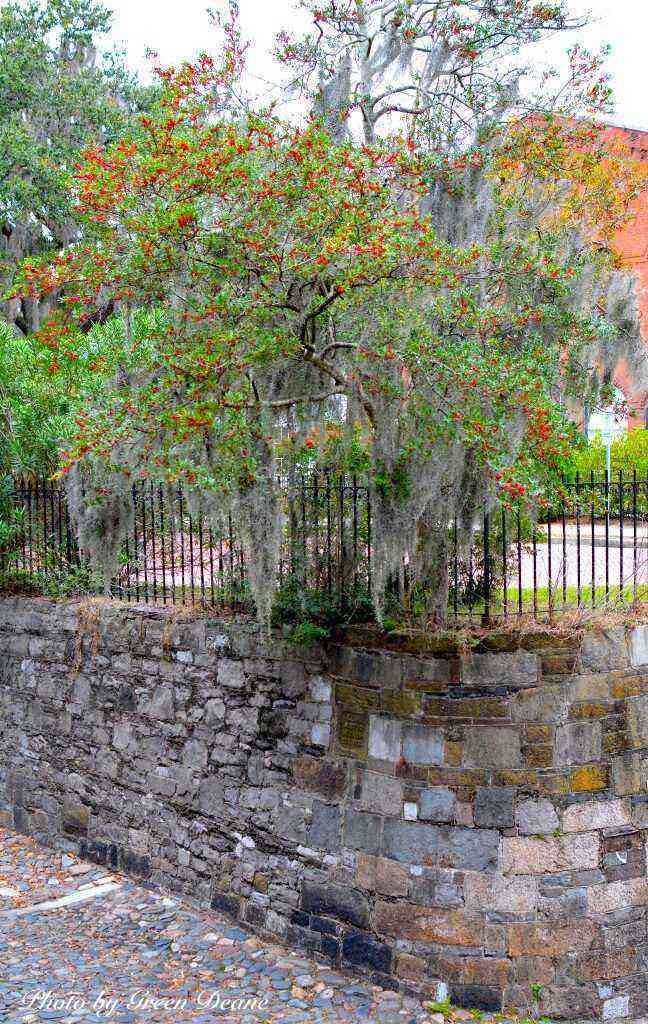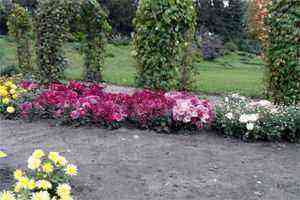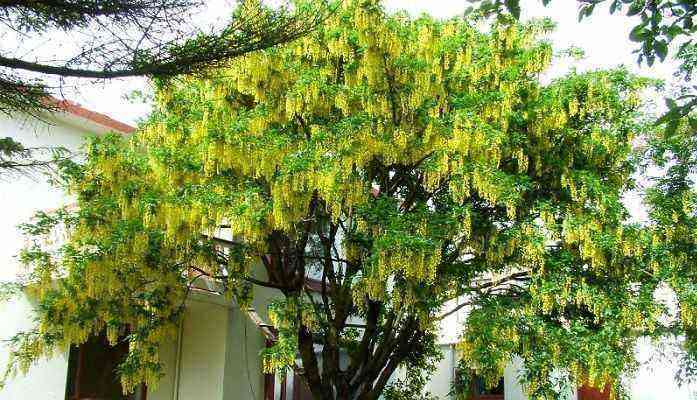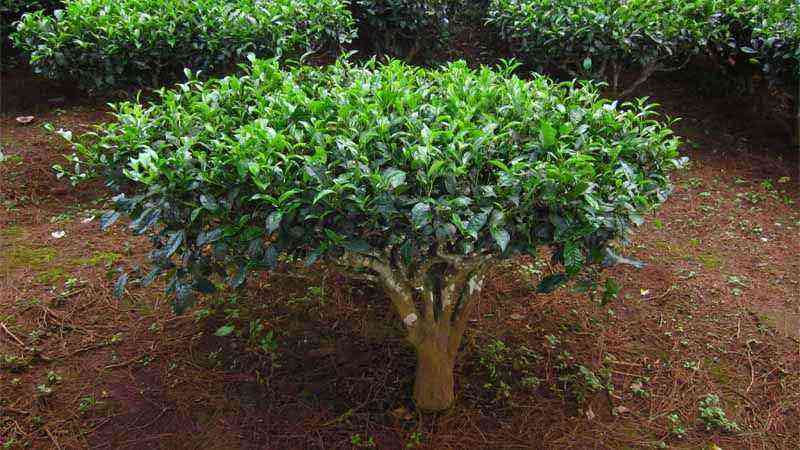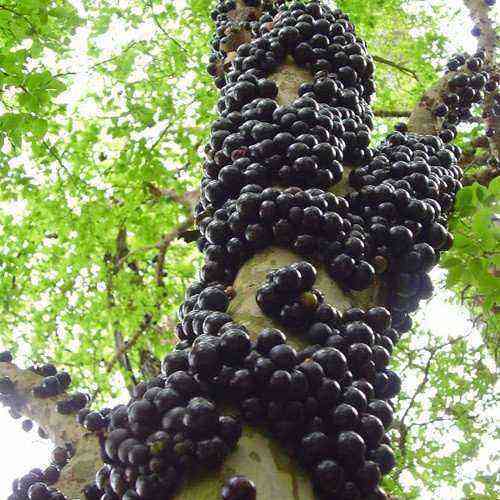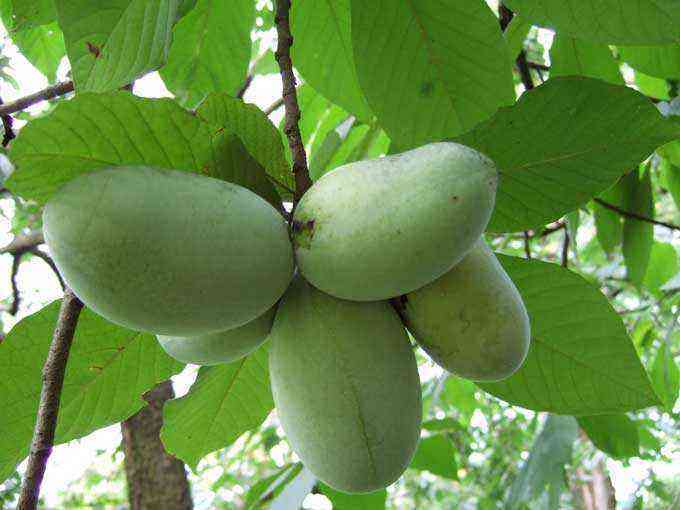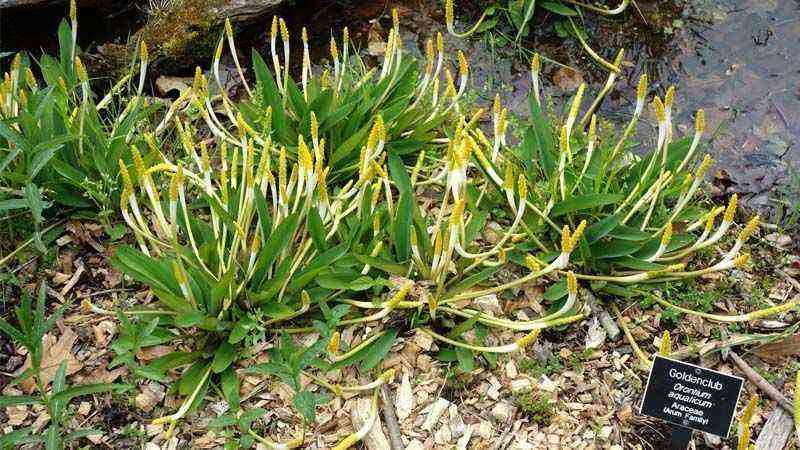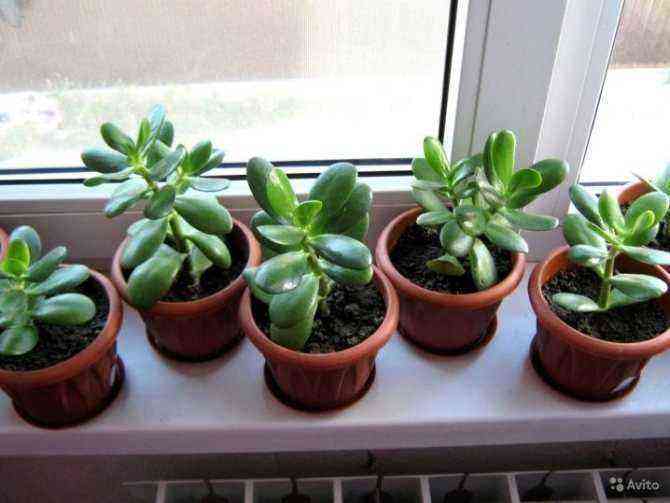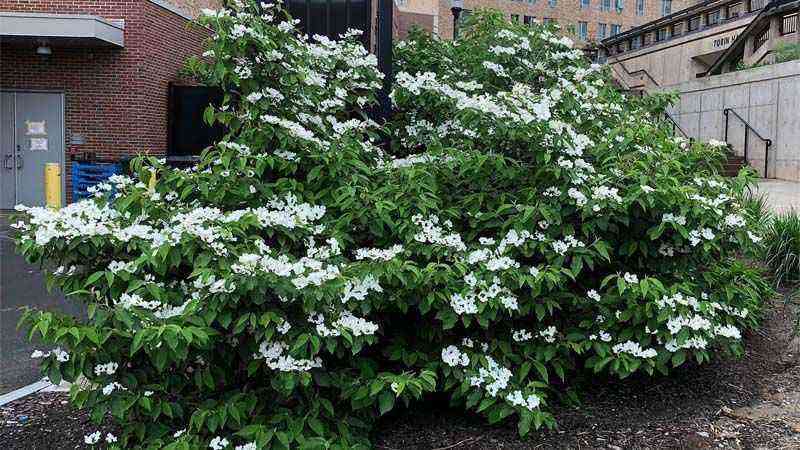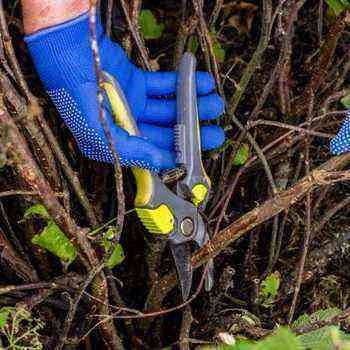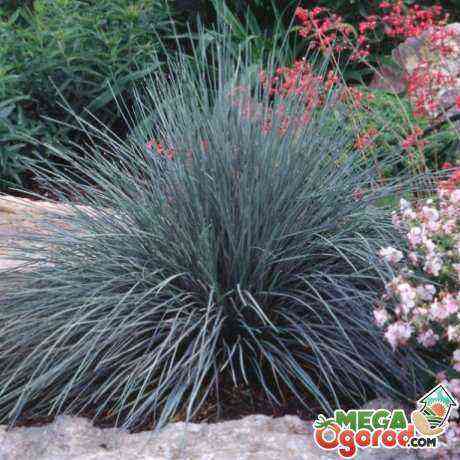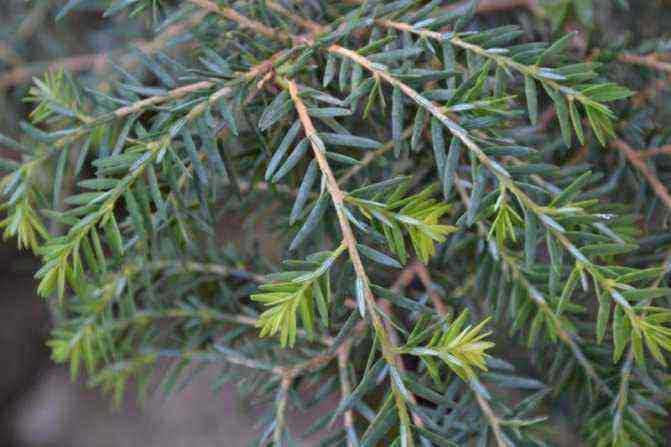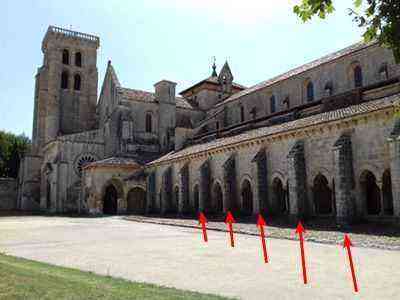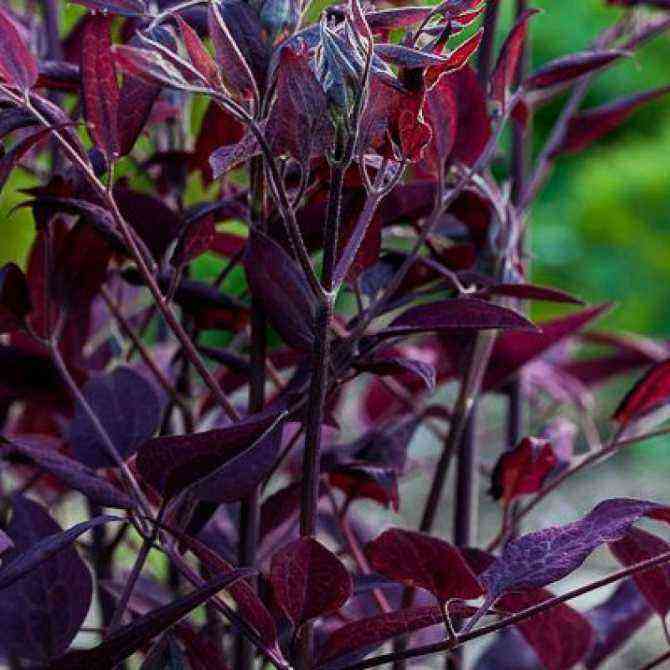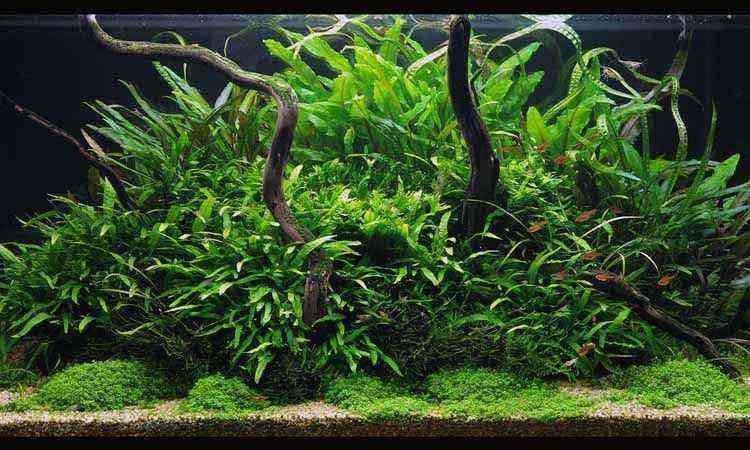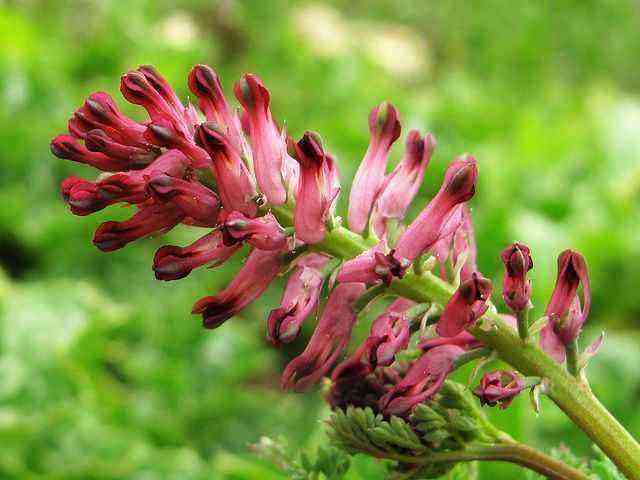- 63219
- garden design hedge thuja
Thuja is a genus of conifers belonging to the Cypress family. They are evergreen and delight with their rich color all year round.
The unpretentious and evergreen thuja is a worthy decoration of any garden, and as a fence it is universal. Thuja thickets can create a “green fence” up to 20 m high. It can be used to make a simple fence or to give trees various shapes: arches, balls, sculptures, etc.
Thuja has a good haircut and retains its shape for a long time. In addition, thuja fills the air around itself with phytoncides, which have a positive effect on human health.
It also protects against gases, dirt, dust, wind.
Thuja hedge
Thuja is a genus of conifers belonging to the Cypress family. They are evergreen and delight with their rich color all year round.
The unpretentious and evergreen thuja is a worthy decoration of any garden, and as a fence it is universal. Thuja thickets can create a “green fence” up to 20 m high. It can be used to make a simple fence or to give trees various shapes: arches, balls, sculptures, etc.
Thuja has a good haircut and retains its shape for a long time. In addition, thuja fills the air around itself with phytoncides, which have a positive effect on human health.
It also protects against gases, dirt, dust, wind.
The use of thuja in landscape design
- In addition to being unpretentious to growing conditions, thuja have the following advantages:
- the needles are soft and colored in different shades of green: from golden to rich dark green;
- color brightness remains even in winter;
- the bark also has a decorative color;
- the crown lends itself well to a haircut, it is easily restored after it and retains the created shape for a long time;
- a variety of natural forms: cone, pyramid, ball, weeping crown structure.
For these features, thuja trees are very fond of landscape designers.
Important! In combined compositions, it is important to select
«
neighbors
»
not only matching in color, but also preferring the same soil structure. Juniper and other conifers, barberries, roses and cereals will be ideal companions for thuja.
They willingly create beautiful single and group compositions from them:
- an emerald cone or sphere does an excellent job of being a tapeworm on a garden lawn;
- columnar varieties are often used as a reliable, impenetrable, but very beautiful green fence;
- exquisite living borders are grown from dwarf forms;
- in combination with other coniferous or deciduous trees, shrubs or flowering crops, thuja become the main elements of a rocky garden and rock garden;
- all thuja varieties are actively used in topiary art: sculptures of people, animals, fairy-tale characters and various objects are carved from them.
Which thuja is best for a hedge
There are a huge number of species and varieties of thuja. Thuja Smaragd and Brabant are best suited for hedges.
Thuja Smaragd hedge
Smaragd is a rather unpretentious plant to care for, characterized by frost and wind resistance. Trees have a conical crown and can grow up to 5-6 m. The disadvantage of this variety is slow growth, so it will take a long time to form a hedge from it.
Hedge from Brabant
Fast growing hedge thuja such as Brabant are more in demand than Smaragd. This plant is resistant to winter frosts, unpretentious in care and is characterized by rapid growth (up to 30 cm per year). The seedlings are planted at a distance of 1 m, and after about two years the height of the hedge will be about 4 m.With frequent haircuts, which is best done in spring or late summer, this variety becomes lush and thicker, so you can get dense and tall thickets in a short time.
Benefits of Tui Brabant
- Fast growth;
- Evergreen needles;
- Unpretentious care;
- Frost resistance;
- Increased decorativeness and a well-growing crown.
Varietal variety
Thuja is a distant relative of cypress. There are 6 known species of it, found in the wild in Asia and the American continent. A common recognizable feature is the characteristic flat branches with leaves reminiscent of needles; in young thujas they are needle-like and soft, in adults they are scaly.
My home is my fortress Source i.pinimg.com
Landscape designers often use varieties obtained from western thuja, which take root in the climatic conditions of central Russia. They can easily withstand low temperatures (down to -35 ° C) and tolerate the urban atmosphere. Breeders divide thuja into several categories:
- Stamp. Decorative varieties in the form of miniature and small trees; there are spherical and weeping crowns in shape. Standard varieties (stem – trunk) will decorate the front lawn in front of the house. They are perfect for decorating a garden in a formal style.
- Spherical. Plants of rounded shape, popular in landscaping, are resistant to the Russian climate. In addition to full-size (from 1 to 2 m) varieties, many dwarf varieties with interesting shades of needles have been bred. Ball-shaped babies are found in a variety of landscape compositions, they are used to decorate alpine slides, flower beds, and grown in containers.
- Conical. They are divided into tall and dwarf. From the point of view of organizing a full-fledged green fence, tall specimens are interesting.
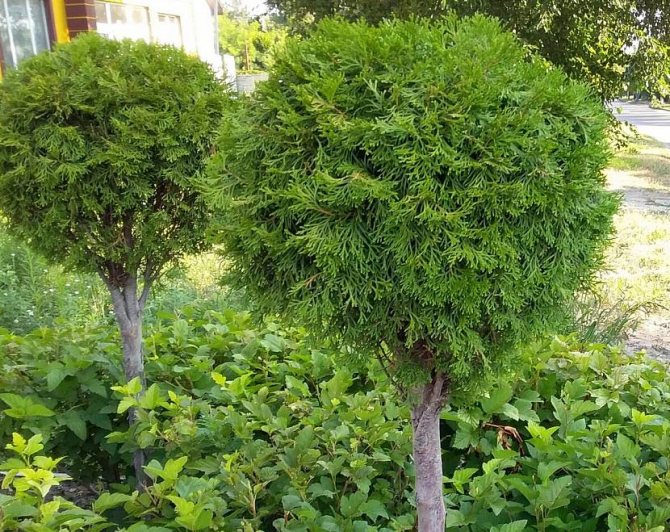

Tui on Press Source avatars.mds.farmer-online.com
See also: Companies specializing in landscaping, including landscaping the site, planting plants, arranging rock gardens
Thuja high
The group includes trees reaching a height of three or more meters. The difference between the varieties lies in the color of the needles and the variety of textures. The crown has a neat columnar or pyramidal (narrow conical) shape, which makes them ideal material for green fences. An additional plus is rapid growth, unpretentiousness and year-round preservation of decorativeness. In amateur gardening, the following high varieties are common:
- Thuja western Brabant. A majestic tree with a columnar compact crown of a light green hue. It stretches more than 3,5-4 m and is well adapted to the urban environment. Thuja is moisture-loving and frost-resistant, but does not like winter temperature fluctuations with prolonged thaws. Not afraid of shade, but in the open sun, the crown has a more decorative look. Suitable for the formation of a perfect alley and green fence.
Brabant variety Source tradingview.com
- Thuya Smaragd. Its compact crown has a symmetrical conical shape and needles of a rich emerald color. Thuja grows up to 5 m, the crown increases only up to 1,8 m in volume. The variety is known for its unhurried growth (10-15 cm annually), longevity, unpretentiousness to weather whims and fertility of the earth. Easily adapts to the urban atmosphere. Thuja Smaragd fence is a popular option for arranging the border of the site.
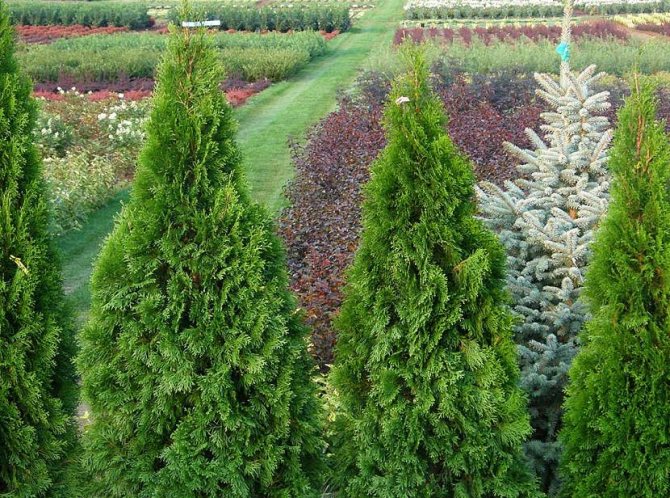
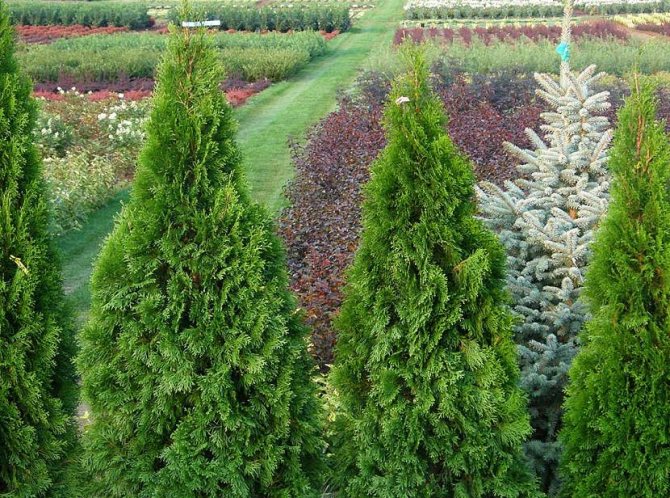
Tuya Smaragd Source farmer-online.com
- Thuja columnar (Columna). Shade-tolerant tree with dark green needles. In Russian conditions, it grows up to 10-12 m, lives up to 100 years. It tolerates frosts to the latitude of St. Petersburg without any problems. It copes well with urban conditions (dust, gas pollution), strong winds and dry periods. Due to the fact that the needles fit snugly against the trunk, trees in planting create a dense decorative wall that perfectly tolerates a haircut.

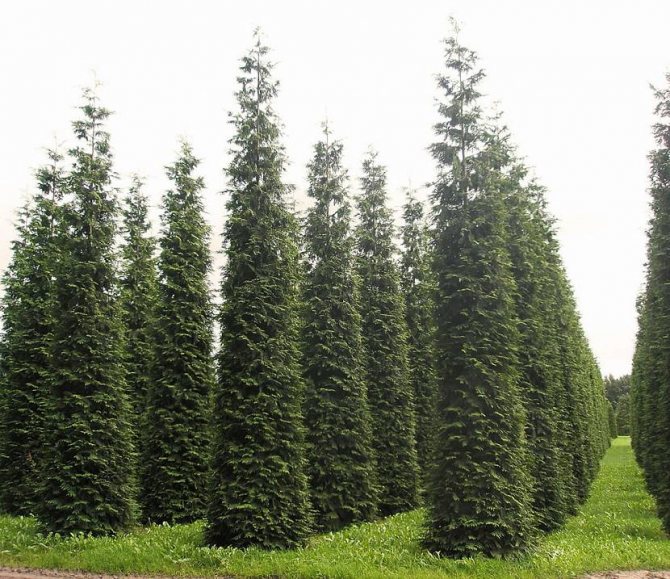
Thuja columnar Source https://farmer-online.com/
- Thuya Golden Smaragd. An unusually decorative variety with a perfectly conical crown and bright needles in golden yellow tones. Also known as Janed Gold. In 10 years it grows by 2 m, retains its color all year round, but in the shade the golden color disappears. Prefers sun and moist, fertile, well-drained soil. Recommended for the formation of living fences.


Seedlings of the Golden Smaragd variety Source i0.wp.com
- Tuya Holmstrup. The dense structure of the conical crown makes this cultivar one of the most suitable for growing evergreen hedges. The height of an adult specimen does not exceed 3-4 m, the average diameter varies within a meter. Annual growth does not exceed 12-15 cm. It grows equally well in the sun and in partial shade, has high frost resistance. The deep green color of the needles is preserved throughout the year.

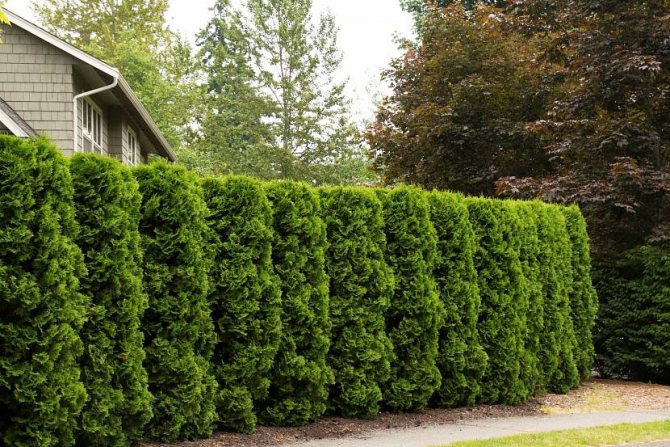
In winter and summer in one color Source i.pinimg.com
- Thuja Fastigiata. Adult thuja are characterized by a columnar crown and fast growth with a maximum growth rate of 6 m. Soft needles have a dark green color and a pleasant resinous smell. Due to the fact that the shoots are not far from the trunk, the plant resembles a cypress in shape. A fence based on this variety turns out to be reliable, looks majestic, economical in terms of the occupied area.
- Tuya Rosenthal. Columnar shrub with a slow growth rate: by the age of 30 it grows up to 2-3 m. The dense, narrow-conical crown makes it a suitable candidate for organizing a picturesque alley or a reliable fence. Frost and wind resistant, has strong branches that can withstand the weight of a snow cap. Unpretentious, grows on any soil, prefers moderate moisture.


With flowers in the foreground Source plodogorod.com
How to plant a thuja for a hedge
This plant prefers shade and partial shade, but it grows well in the sun if it is regularly watered.
If you want a thuja of a pure variety, for a certain climate, resistant to various diseases, viable, then it is better to buy a plant in a nursery or garden.
In addition to seedlings, thuja reproduces both by seeds and cuttings, which are prepared in April-May. Thuja grows from seeds poorly or does not grow at all, even with careful and proper care, such a thuja does not take root. Therefore, it is better to take seedlings that are planted in spring.
When buying, you need to look at the roots, they must be healthy and whole. Trees should be transported carefully, without breaking branches and roots.
Thuja Brabant hedge planting rules
The distance between the thuja in the hedge depends on the purpose of the hedge, on the variety of thuja, the height and width of the trunk are also taken into account:
- when planting one row, it is better to leave a distance of 80 to 100 cm;
- for a two-row hedge, the distance reaches 2 m and the seedlings are planted in a checkerboard pattern;
- if the thuja variety is large, then the distance between the plants can reach up to 5 m.
Planting thuja for hedges
- Seedlings are planted in a hole with a depth of at least one meter
- Release the roots from the cover directly in the pit;
- When planting, the root collar must be level with the ground, otherwise the tree will begin to rot or dry out;
- After that, the roots are covered with either a mixture of peat and earth, or ready-made purchased land;
- The soil around the tree is trampled so that there are no voids left, and it is watered abundantly so that the earth is saturated to the very roots.
a) the root system of the seedling is freed from the cover directly in the planting pit, b) the spread roots are sprinkled with an earthen mixture, c) the soil around the seedling is trampled so that no voids remain, d) the plantings are watered so that the earthen lump is completely saturated with moisture.
Any soil is suitable for planting, but it is best to put peat with sand and fertilizer in the seedling hole.
Thuja transfers planting and transplanting quite easily, thanks to its compact root system.
Why does thuja “smaragd” turn yellow in autumn?
Yellowing of the needles indicates the presence of problems in the immune system, and this easily leads to diseases and pests.
The most common causes of yellowing are:
- Improper planting – deepening of the root collar, lack of preliminary watering before planting, destruction of the earthen coma before transplanting the seedling into the ground.
- Dust. It settles on small scales and blocks them. Breathing is impaired. The tree begins to suffer. For cleansing, sprinkling is carried out on a regular basis.
- Spring burns. With lengthening daylight hours, the plant wakes up, sap flow begins, but the soil is not yet ready to release nutrients, it has not thawed yet. The needles suffer from dehydration and dry out. For protection, the tree is covered on the south side with a white non-woven fabric to protect it from the scorching rays. Be sure to leave room for air circulation. And spill the soil around with water at room temperature (young trees – 4–5 liters, for an adult tree – 10 liters). Then feed the mullein with a solution, mulch the soil around the trunk, and carefully cut off the dried branches.
- Pests and diseases. Tuyu can be affected by sucking insects, stem pests. They can weave cocoons on needles (gray larch leafworm), suck nutritious sap from the plant (thuja aphid and pseudo-scale insects, juniper scale insects, bedbugs, mealybugs, moths), eat thuja twigs (caterpillar of the mayfly bagworm), gnaw holes in the trunk ), eat the needles and bark of young trees (weevils).
- Lack of minerals. Depleted soil will cause the plant to wilt. It is necessary to compensate for the shortage by watering with fertilizers.
Regardless of the reason for the yellowing of the needles, all dried branches are cut off.
Catalog of thuja smaragd seedlings nursery in the Moscow region (Yakhroma).
Thuja hedge care
Caring for a thuja hedge is simple:
- watering depends on the condition of the soil, and on the location of groundwater. It is enough to water once a week, spending a bucket of water for each plant. In dry season – 1,5-2 buckets of water twice a week;
- loosening is carried out after each watering;
- the soil should be mulched with peat or chips a month after planting;
- every spring it is necessary to apply compost and mineral fertilizers;
- cover young seedlings from the sun until they get stronger;
- it is better to cut thuja in spring and autumn, removing old branches and forming a crown.
Thus, with proper care and selection of the variety, you can get a decorative and effective hedge in a short time.
Time to land
The best time for planting thuja outdoors is early spring. Planting in spring will provide the necessary amount of time for the tree to take root and take root. Thuja planting time depends on the climate of the region. In areas where severe winters are not observed, it can be planted not only in March, but also in autumn, at the beginning of October. Autumn planting dates should be carried out several weeks before the onset of frost so that the plant has time to root well. Also, if urgently needed, you can plant a tree in the summer, but choose a cloudy or rainy day for that, and plant it in the evening.
Help to plant the thuja hedge correctly!
Our subscriber of the VKontakte group Olga Karandeeva asked for advice:
Hello everyone. Help with advice, I want to plant a hedge of thuja. So far, only along one of the boundaries of the site, in order to isolate oneself from the neighbor’s hut in the future (nothing personal, just the kind of trees is more pleasant to me).
An aggravating circumstance – along the same border, it is advisable to lay drainage in order to divert water from the entry zone.
The questions are as follows:
- What to do closer to the fence – a thuja or a drainage pipe?
- Do I need to alternate thuj varieties? I saw someone’s scheme of smaragd-3 brabandt-smaragd, why is this done?
- Well, and the last question – is it possible to plant now, in August, or is it better to wait for spring?
Thank you all in advance for your answers.
Can we help Olga with advice?
Discussion in our group on VKontakte:
Elena Truusa: I planted my thuja in the fall. All got accustomed. The smaragd is cone-shaped, grows slowly, the needles are dense, it is rarely cut off. But the brabants need to be cut. Of these, very beautiful hedges. It is not worth planting close to neighbors, complaints will begin that you are blocking the light. And in dry summer they need to be watered over the needles, they love it.
On the first photo there are my single brabants and on the second one there are emeralds, there are almost 30 of them.
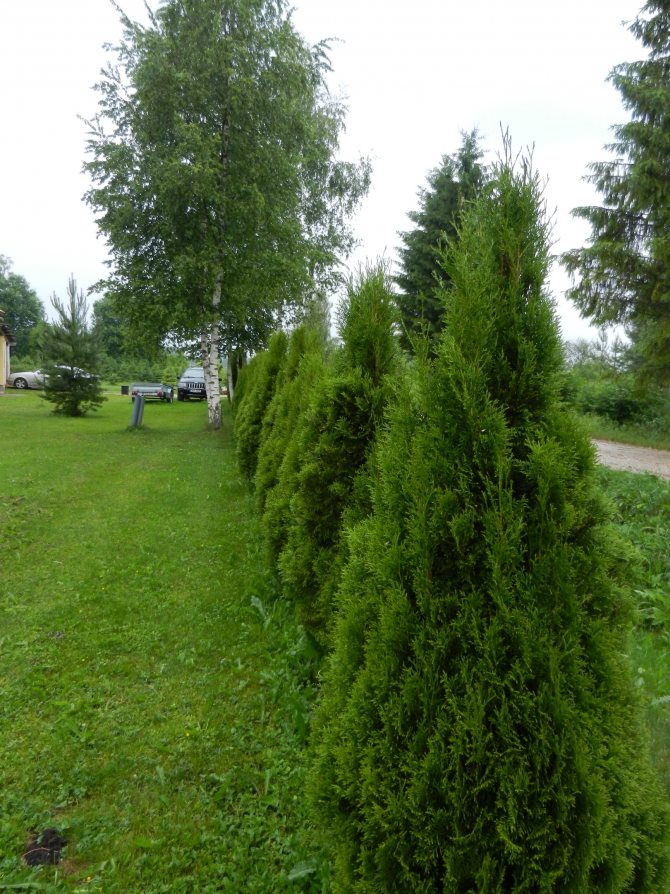
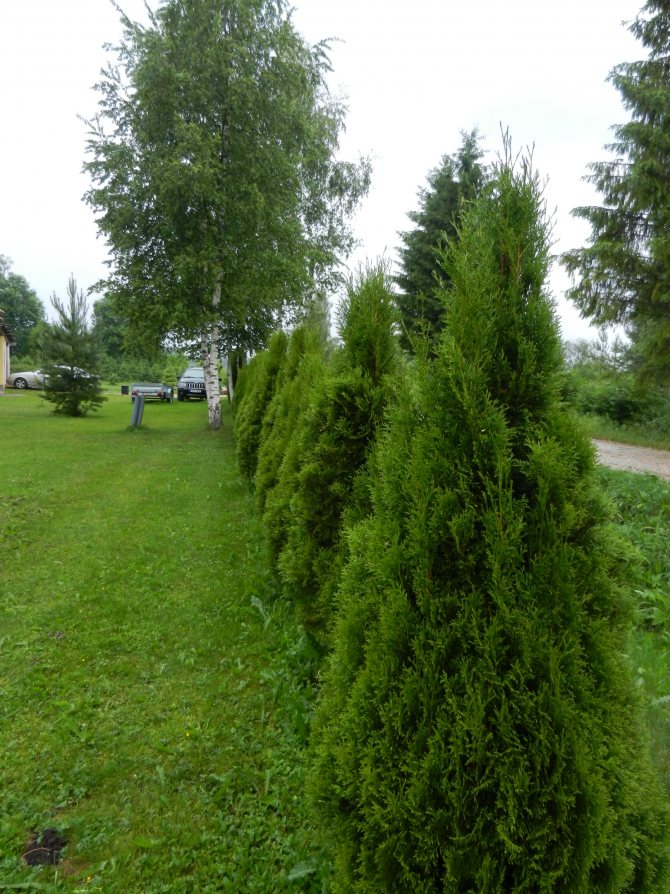
Elena Truusa: And this is thuja kolumna.
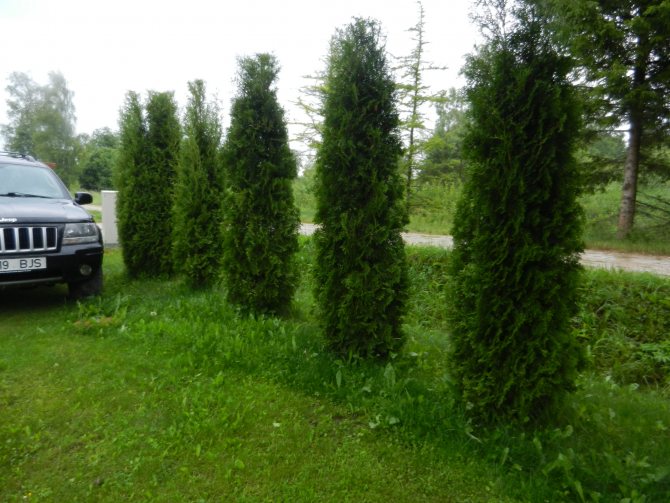
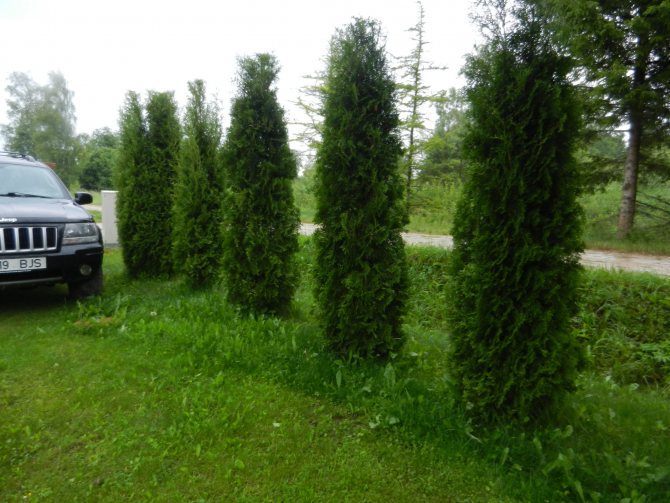
Andrey Pisarenko: Snow will fall from the roof. Consider this. Olga Karandeeva: Elena, in my case I block the light only for myself, this is the southern border of my site. How many cm would you advise to retreat from the fence if you choose a brabant? And is it worth spilling Zircon / Kornevin after planting? Olga Karandeeva: Andrey, an important note. But this photo angle gives the false impression that the overhang of the neighbor’s roof is over the fence. In fact, his snow falls exclusively towards him. Lyudmila Mirnaya: Olga, according to SNiP, you cannot plant trees closer to the (neighbor’s) fence closer than 4 meters, and shrubs – two meters Evgeniya Alekseeva: A very beautiful hedge is obtained from thujas, alternating with red-leaved barberry. Elena Truusa: The landing frequency of the brabant is -1 m. I think that one meter should also be retreated from the fence. We do not sell zircon and root root. I started fertilizing in the spring with special fertilizers for conifers, and I still use them. Tamara Cheusenko: Brabant, planted on October 4, 2020, retreated 1,5 meters from the fence and there is a distance of 1,0 meters between them, the height of the fence is 2,0 meters, that’s how they stretched out in four years.
Advantages and disadvantages of thuja hedges
Thuja is a popular option for forming a hedge. She really has many advantages:
- life expectancy is 50–100 years;
- year-round decorativeness (needles in winter can change their shade, but do not fall off);
- varietal variety (thuja differ in height, crown shape, color of needles);
- undemanding to the quality of the substrate;
- good winter hardiness (at least -25 ° C);
- the density of the crown (sufficient not only to protect the site from dust, noise, drafts, snow drifts, but also from animals and other unwanted guests);
- good mowing tolerance and the ability to give trees a variety of configurations;
- improvement of the atmosphere (any conifers release phytoncides into the air, destroying microbes).
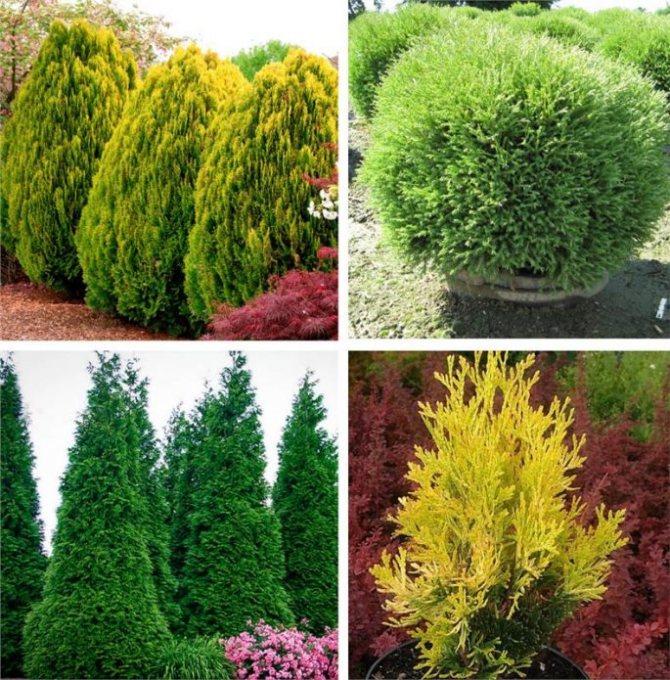
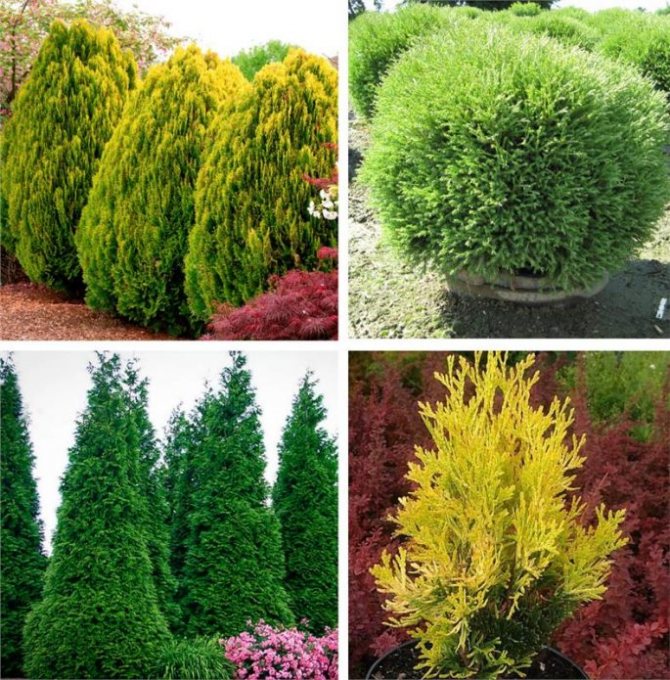
A variety of thuja varieties allows you to create both a low curb and a blank fence
There are also disadvantages:
- the tendency of needles to burn out in direct sunlight;
- the need for special protection of young specimens from frost;
- high cost of seedlings.

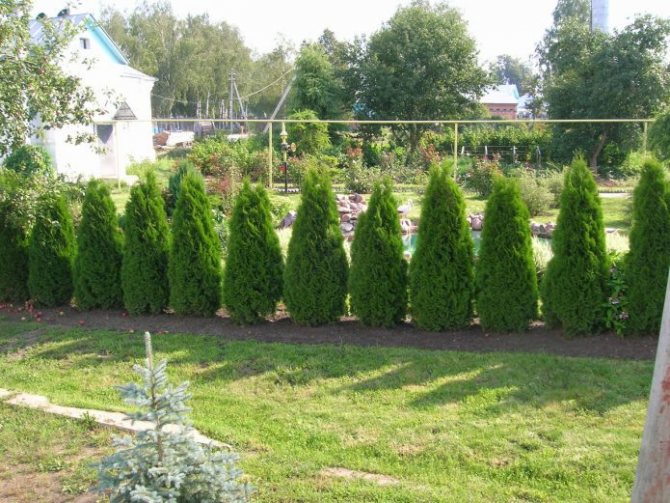
Thuja hedge – a successful combination of decorativeness and functionality
What varieties are suitable for planting a green fence: photos and descriptions
To form a hedge, thuja varieties are most often used:
- Brabant. Height up to 5 m, crown in the form of a wide column. Fast-growing, highly winter-resistant. In spring, it does not tolerate direct sunlight. In winter, the needles become reddish brown.
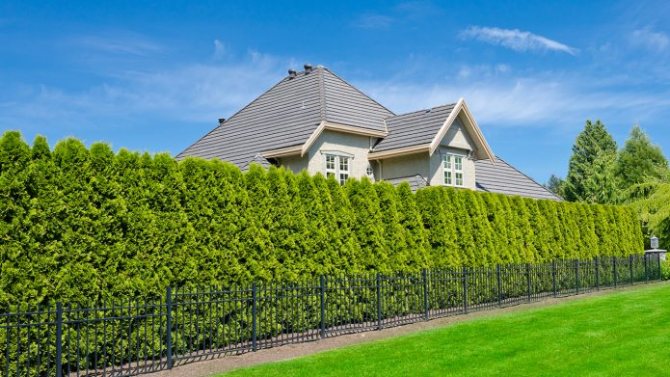
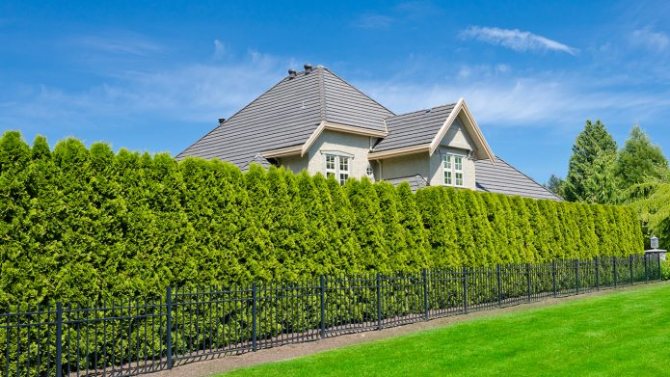
Thuja Brabant is distinguished by its growth rate – this is important for those who want to get a hedge faster
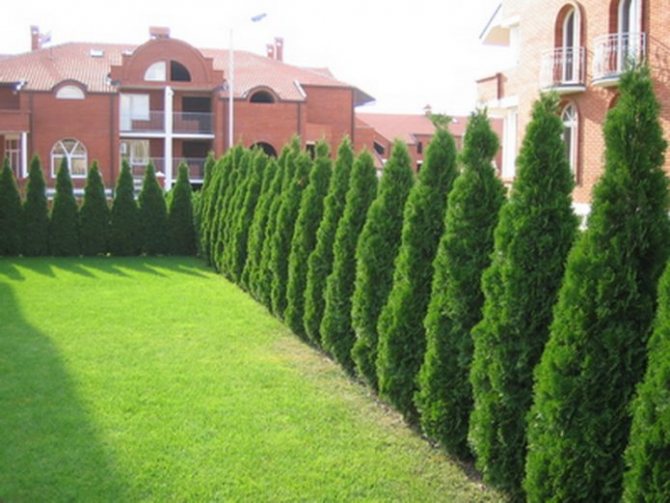
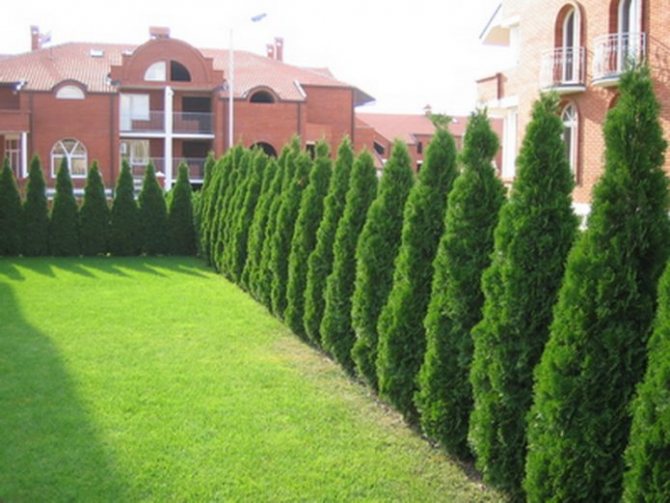
Thuja Smagard grows slowly – a hedge is formed for a long time, but it can be trimmed less often
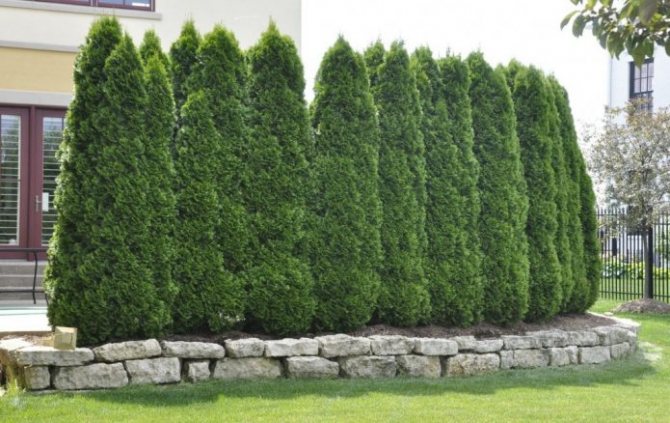
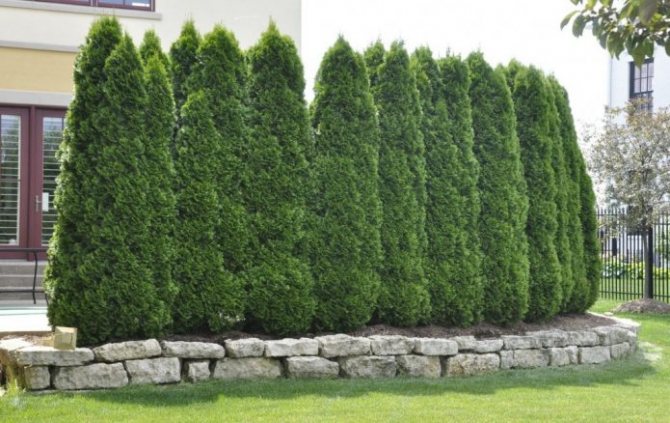
Thuja Columna throughout the year does not change the shade of the needles

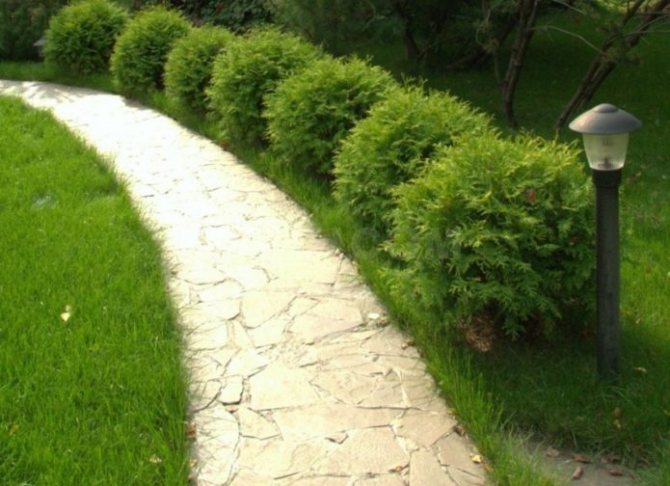
Tuya Danika – ideal for creating low curbs and zoning the site
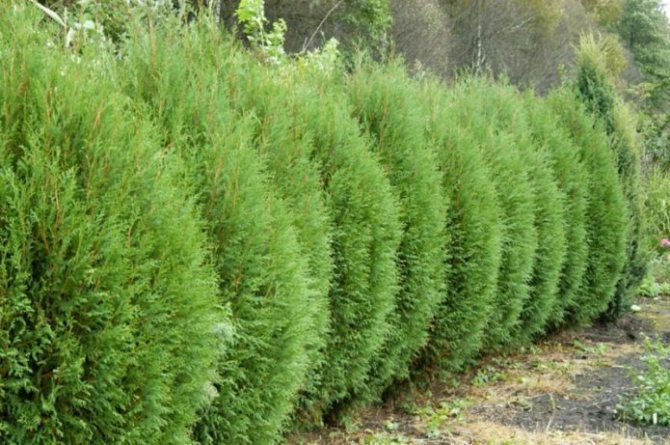
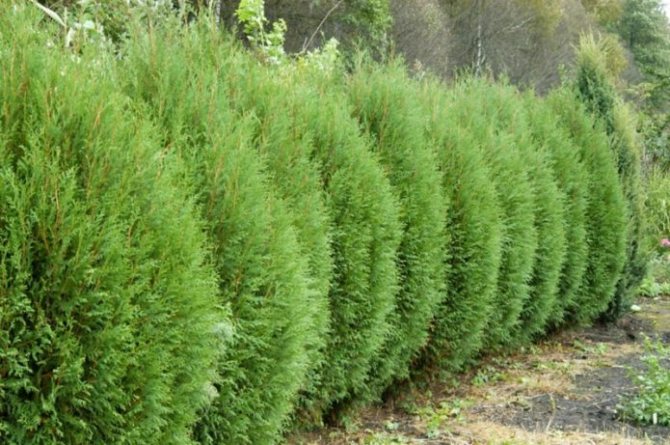
Thuja Wagner, in comparison with “relatives”, is more demanding on the quality of the substrate
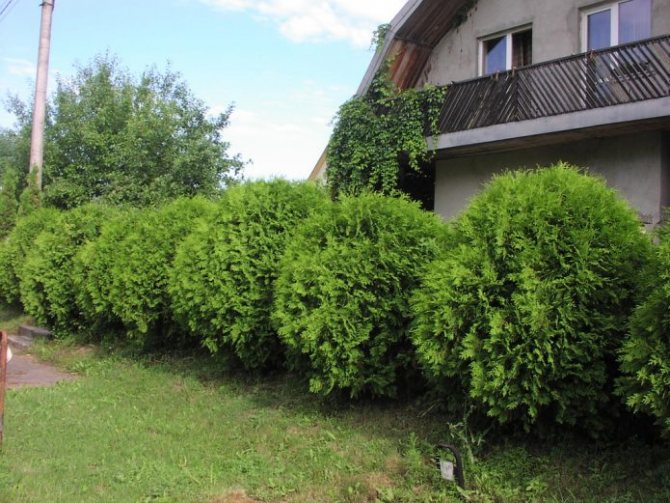
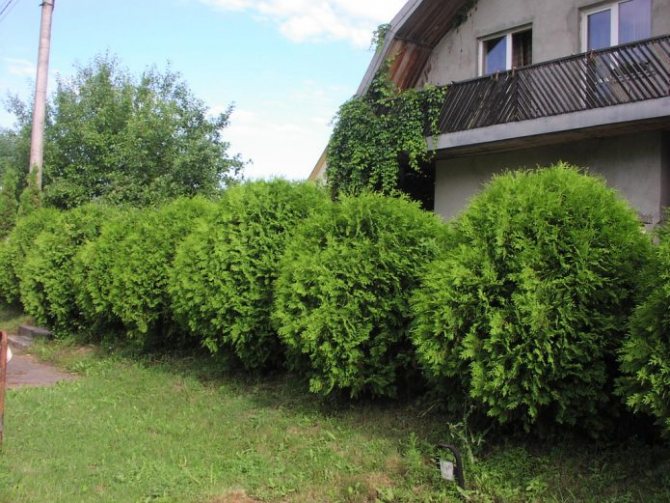
Thu Globoza can be planted even in thick shade
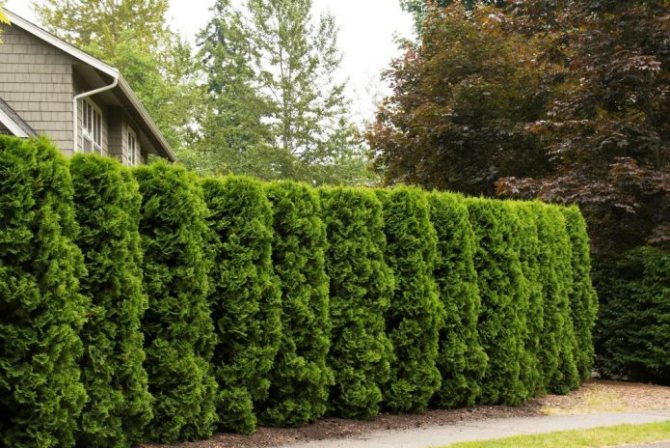
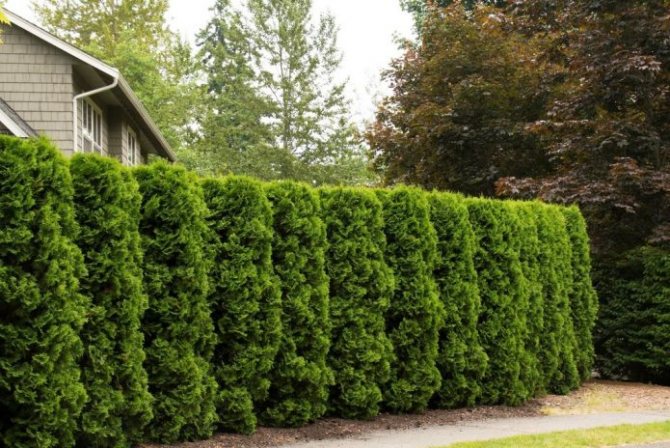
Thuja Holmstrup stands out for its unusual texture of needles
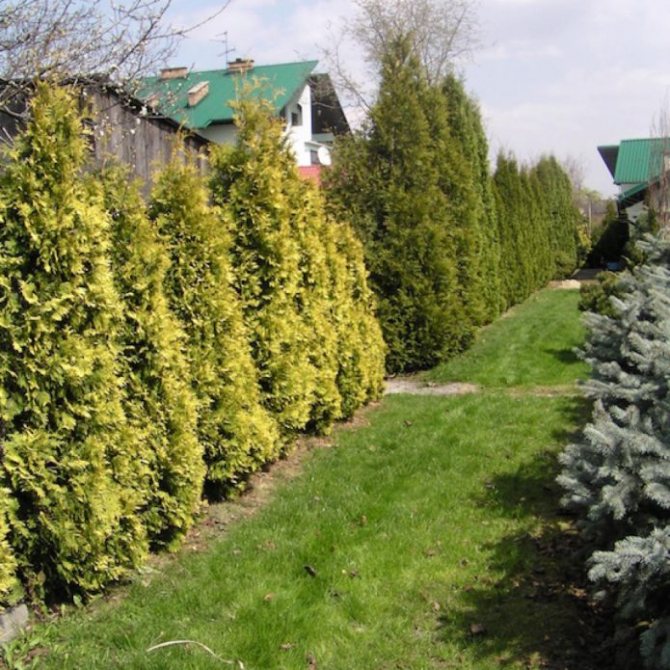

Tuya Sankist pleases the eye with an original shade of needles
Video: how to choose a variety of thuja for the formation of a hedge
Tips for Beginners
Starting to grow thuja, you should know:
- sunny places or light partial shade are suitable for planting;
- in a thick shade, the needles will fade, and the crown will thin out;
- the soil must be breathable, loose, moist;
- the landing pit is prepared in advance, its average size is 70 by 100 cm;
- the root collar should be located above the soil surface;
- humidify the air around the crown so that the needles do not dry out and crumble;
- Thuja Smaragd seedling should not be left in the winter in an apartment or house, the container with the plant must be dug in the street until spring.
What is the danger of planting thuja Smaragd in the house
Recently, planting of thuja in the house, on the veranda, balcony, terrace has become very popular. The plant is very decorative, creates comfort around itself, coniferous aroma. According to the description and photo, the size of the thuja Smaragd, the volume of the root system suggest its cultivation in open ground, on the street, where there is enough space and nutrients in the soil.
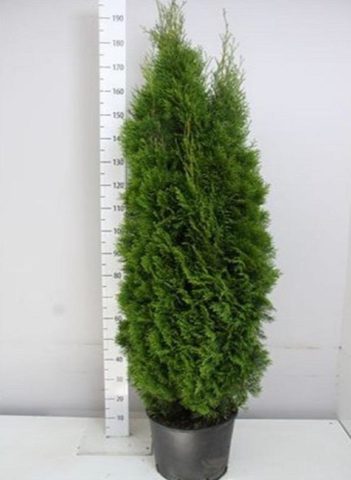
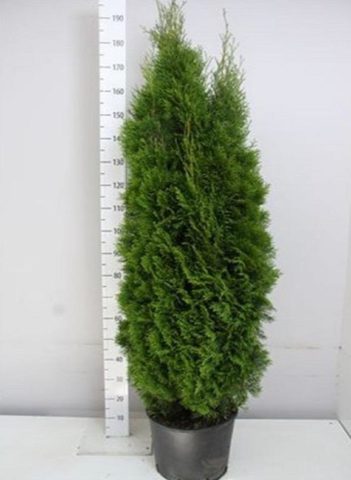
Growing in a pot or tub leads to drying out in the summer and freezing of the roots in the winter. It is dangerous to leave the plant in the room for the winter. At home, thuja will not be able to survive, since the tree needs a dormant period.
How quickly thuja Smaragd grows
Thuja Smaragd will take several years to reach its maximum height. Depending on the variety, the annual growth is from 10 cm to 50 cm. Life expectancy is from 50 to 150 years. The tree grows quite quickly and after 4 years it reaches a height of 2,5 m. The diameter of its crown at this moment is about 70 – 80 cm. The ability to accelerate growth is used to create hedges from plants in a short time.
How to accelerate the growth of thuja Smaragd
To accelerate the growth of thuja, gardeners use several simple and well-known methods:
- Regular watering and sprinkling of the crown is carried out, avoiding waterlogging of the soil.
- From the fourth year of life, pruning of the tops of the shoots begins, contributing to a more intensive growth of thuja branches.
- Carry out potash, phosphorus fertilizing, which increase and accelerate the annual growth.
How to thicken the crown at the root of thuja Smaragd
Do not be afraid of trimming the top of the thuja if it is very stretched or dried out. After shortening, healthy branches receive enhanced nutrition, thanks to which the crown becomes thicker, it is possible to give it a new interesting shape. The summit will recover over time. It is recommended to carry out such pruning at least once every two years.
How to plant a hedge
Thuja is planted both in spring (April-May) and in autumn (until mid-October). The second option is preferable for regions with a warm climate. It is better to place the hedge in partial shade; in an open area, more frequent watering will be required. The tree will take root in any soil, except for heavily swampy, acidified and saline.
The depth of the planting pit is 70–80 cm, the diameter is about the same. When planting densely, it is more convenient to dig one trench. At the bottom, a drainage layer 12–15 cm thick is required. A layer (top 15 cm) of fertile soil is mixed with humus (15 l), peat (5–7 l) and a complex nitrogen-phosphorus-potassium fertilizer (100–120 g). This is the norm for one tree or per linear meter.
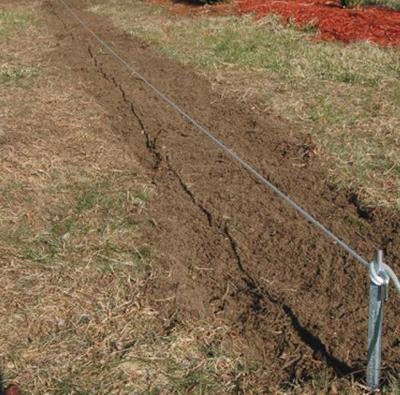
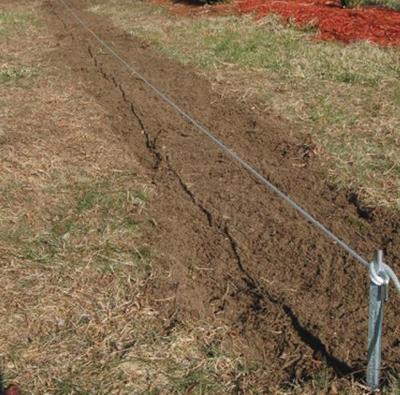
It is recommended to mark the place for a hedge with a rope and pegs – then it will definitely turn out even
Most often, thuja are sold in containers with a closed root system – it is more convenient to plant them. You just need to water the tree abundantly, remove the thuja from the pot, trying not to damage the earthen lump, plant it so that the root collar is at the level of the soil, water the plant abundantly (20–25 l) and mulch the soil about a month after planting.
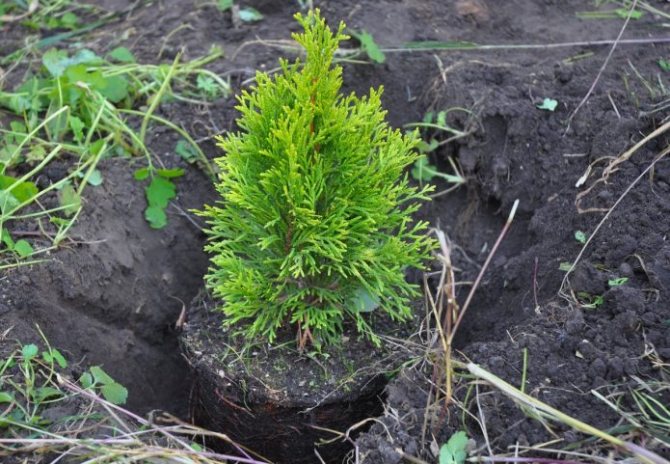

When planting thuja with a closed root system, try to preserve as much as possible a whole earthy clod on the roots.
Video: how to plant thuja correctly
From thuja, you can create any hedge – from almost impassable to purely symbolic. In the first case, the interval between plants is 40-60 cm, in the second – up to 1,5-2 m. When planting along the fence, the distance is reduced to 0,7-0,8 m. A thick two-row hedge looks beautiful – thuja are planted in a checkerboard pattern , leaving about 1–1,2 m between them, and 1 m between the rows.
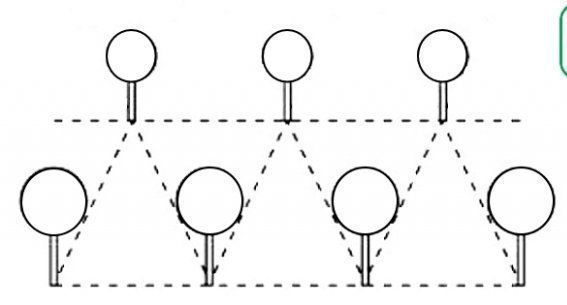
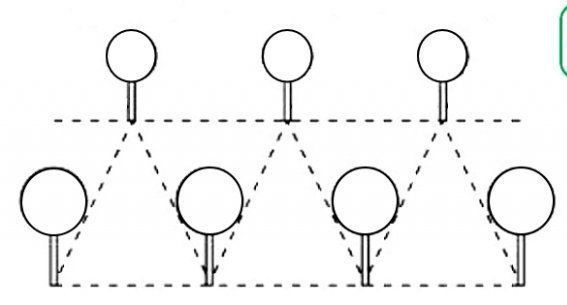
When forming a hedge, thuja can be planted in two rows, but not in three – the middle one is likely to die
Video: planting thuja Smagard along the fence
Application of varieties
Thuja are one of the most versatile conifers. From thuja folded and thuja western varieties ‘Smaragd’ or ‘Aureospicata’, you can create tall hedges (6-10 m in height), although in backyard gardens it is more often found as a tapeworm. Thuja western is better for planting near the house.growing much slower. Most of its varieties grow to 3,5-5 m in height, and ‘Brabant’ and ‘Ellwangeriana’ are excellent hedgerow material, as they become highly compacted by pruning. For loose hedges, conical varieties such as ‘Aurescens’, ‘Columna’, ‘Europe Gold’ and yellow ‘Spiralis’ are recommended. If you decide to choose low shrubs (up to 1,5-2 m), the globular ‘Golden Globe’, ‘Hoveyi’ or ‘Little Champion’ are excellent choices. Western thuja varieties can also be planted in groups and in flower beds, where they will create spectacular compositions with folded thuja. This group includes thuja ovoid or oval-conicalfor example the intense green ‘Justynka’, ‘Nana Aurea’ greenish or gold ‘Elegantissima’ and ‘Pyramidalis Aurea’. These varieties can also be grown in the form of a hedge, but it will be quite dense.
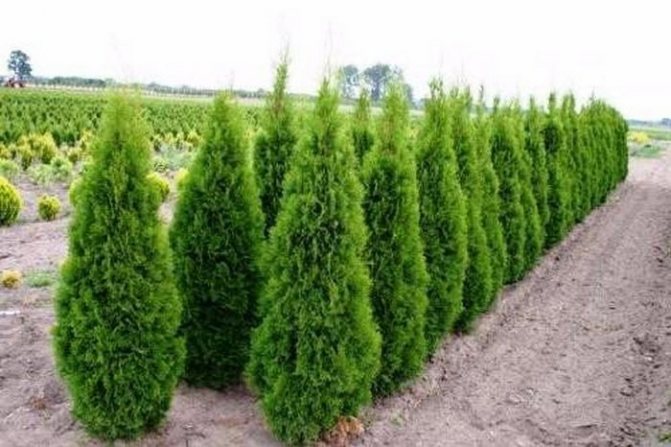
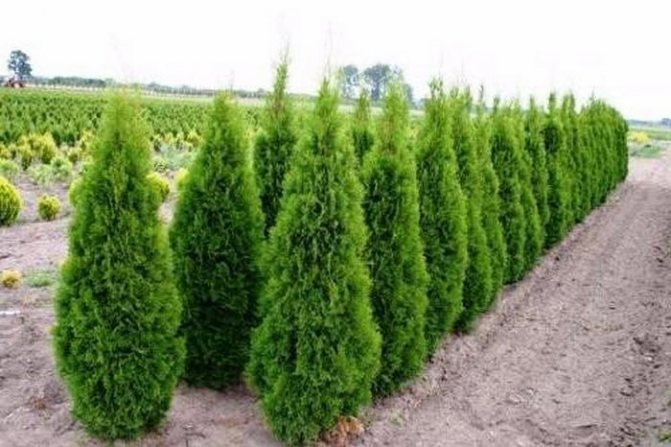
Forming, trimming hedges and other nuances of care
Young thujas need especially careful care. In the first three seasons after planting, they are most susceptible to negative environmental factors. The plants are not fed, they are watered as the topsoil dries up 5–7 cm deep, spending 20–25 liters per tree. If thuja grow in an open place, in the first year, if possible, build a canopy over them of white covering material, protecting them from direct sunlight.
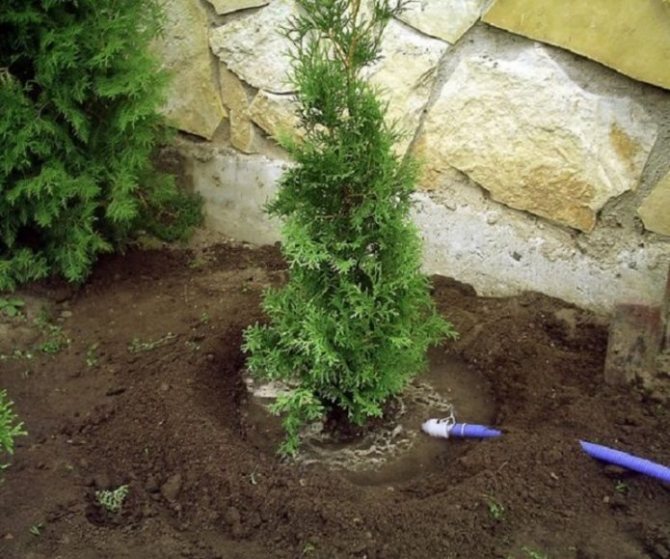
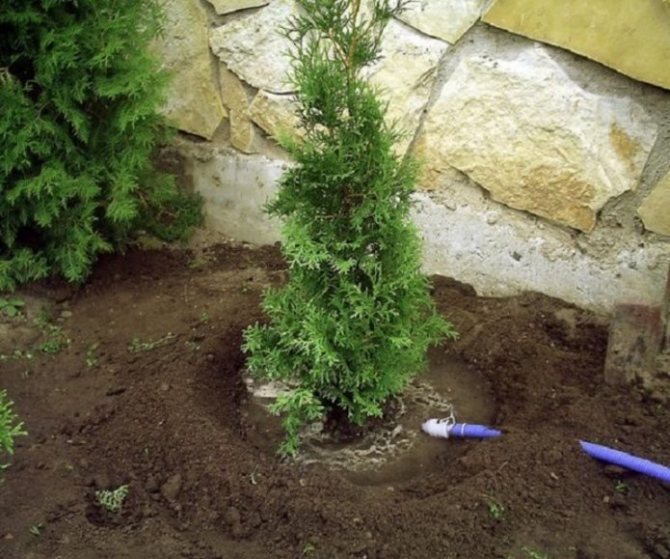
Young thujas are often watered, not allowing the soil to dry out excessively
In late autumn, mulch the roots with peat or humus (a layer up to 15 cm thick). Cover the trees themselves with covers made of a special material – it retains heat, but retains the sun’s rays (thuja do not like winter sun as much as summer sun). The cover should not be close to the tree, leave a gap of 5–7 cm. It is removed when the snow completely melts at a stable above-zero temperature at night.
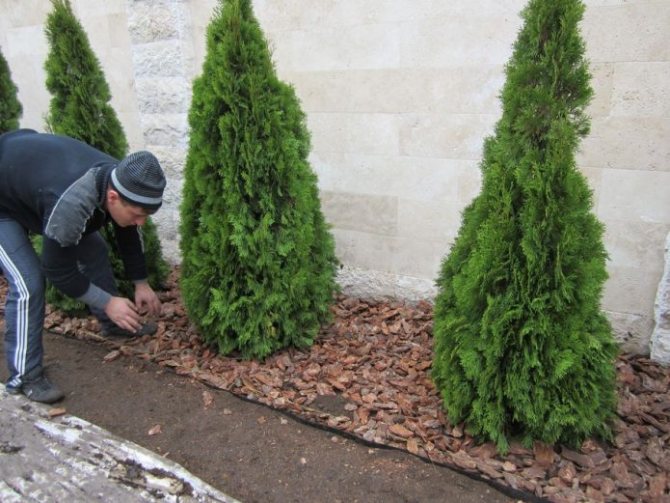

Mulching the soil helps to cope with several problems at once – the rapid loss of moisture in the soil, the growth of weeds, the threat of freezing of the roots in winter
3 years after planting, the thuja are stopped to cover for the winter (mulching of the roots is enough) and begin to cut off. Moderation is important here – no more than a third of the green mass is removed at a time, otherwise the tree will simply dry out. You cannot completely bare the branch – the green mass will no longer be restored.
Make sure that adult thuja without covers are not covered with snow. Otherwise, the needles will start to sing.

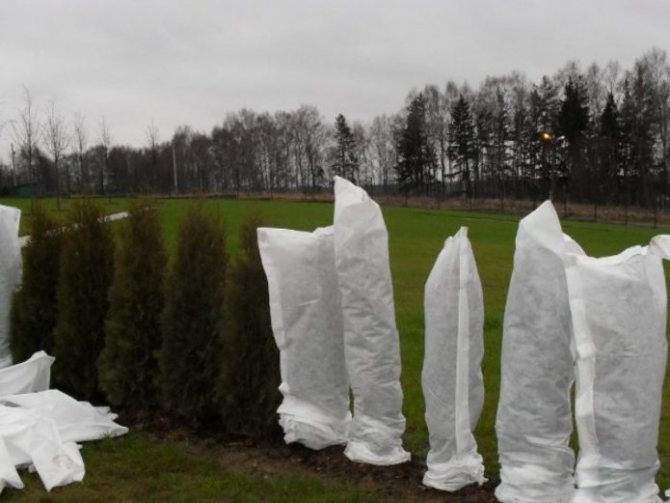
Thuja does not like winter and spring sun in the same way as summer sun, so trees need protection
The timing of pruning for each variety is individual, check this when buying. Young thuja are pruned twice a year, adults – from three times a year to once every two years. But there are also some general rules:
- Excess branches, clearly violating the given configuration and thickening the crown, are cut in late spring or summer.
- If you want to slow down the growth of new shoots, prune in early spring, before the buds have opened yet. When you need to stimulate it, trim the thuja after flowering.
- You cannot cut off all new growth after the previous haircut. Be sure to leave part of the young shoot.
- In the spring and autumn, be sure to carry out sanitary pruning, removing broken, dry, old bare shoots.
- When creating any unusual configuration, keep in mind that the crown should expand from top to bottom. Otherwise, the lower branches, which lack light and heat, become bald, the bottom of the trunk is exposed.
- To give the fence a classic fence shape (rectangular, trapezoidal), a special coarse mesh is most often used. It is pulled over the entire fence and the lateral processes that crawl out through the cells are cut off. Cut the thuja with ordinary scissors or pruning shears, leaving no creases.
Trimming
Tui planted in groups will not grow too much if we cut them off every year. In order for pruning to bring the desired effect, it begins by reducing the number of main shoots. Then, once every 2-3 years, from April to July, we prune the tree around, cutting off all its shoots. Repeating this operation regularly is the key to success.
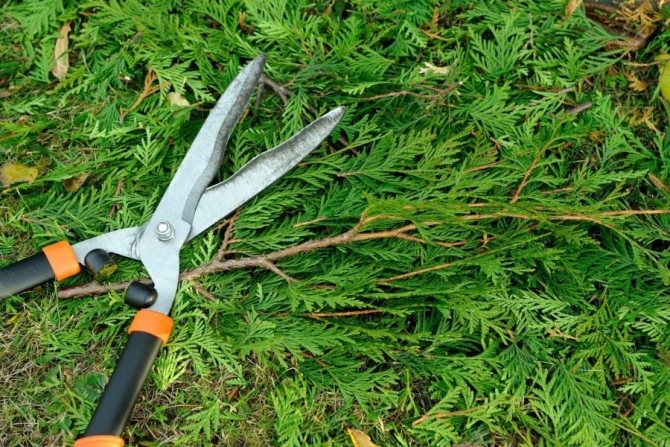
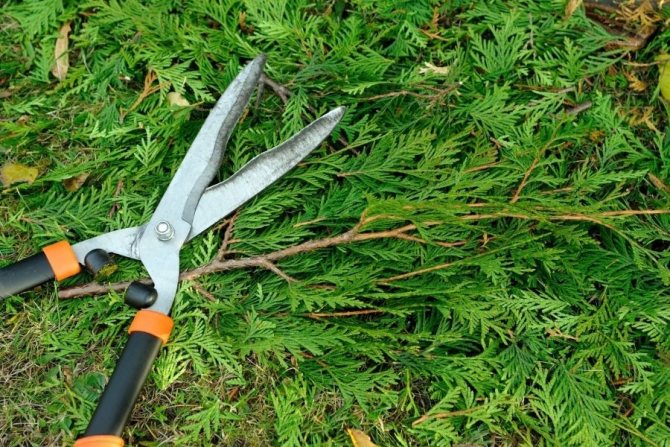
Planting a thuja hedge
Adding an article to a new collection
A thuja hedge is no less practical than any fence. It has served for decades and performs 2 functions at once: it encloses the site and decorates it.
If you are not a fan of ordinary fences, plant a thuja hedge. It looks attractive all year round: it colors the area that has not yet awakened in spring with bright green, creates a good background for summer flower beds and adds color to a faded autumn garden.
What else captivates the thuja hedge? It has many practical functions:
- creates a “shield” from wind, dirt and dust;
- protects the area from snow in winter;
- creates a barrier to entry into the site;
- helps to disguise unsightly buildings in the backyard;
- cleans the air (due to phytoncidal properties);
- creates a cozy atmosphere.
Tui usually grow tall enough, so they make a thick, dense wall that can compete with any fence and become a magnificent frame for the garden. If you plant the seedlings correctly and take good care of them, thuja will become the main element of landscape design.
How to care for a thuja hedge
- After planting the thuja, you need it well to water and then do it regularly (once a week). Otherwise, the needles may begin to crumble.
- In the first three years, thuja need additional feeding. In spring and early summer, nitrogen fertilizers are well suited – urea, ammonium nitrate at the rate of 20-30 g per 1 square meter of the trunk circle, you can use the complex preparation “Kemira-universal” – 100-120 per 1 square meter.
- Periodically, the soil around the plantings must be loosened (to a depth of 10 cm) and weeds must be removed so that they do not take away water and nutrients from young plants.
- After planting, the thuja can be mulched.
- You can cut hedges from the second year after planting. The procedure is carried out in the spring with special garden shears. During this period, the cuts are quickly masked by the growing shoots, and the crown of the plant will become thicker from year to year.
A hedge on your site will always look neat and beautiful if properly planted and given proper attention. Remove unnecessary twigs, replace dead plants, water and feed the thuja in time – and you will have such a hedge that all neighbors will envy.
Distance in group
Planting thujas at the right distance. The specimens to be planted in groups must be at a distance from each other, at least ½ of the maximum possible crown widthotherwise they will compete with each other for space, light and nutrients. Most often, young, not grown trees are planted, therefore, when planning the distance between thujas, you need to find out to what maximum size the variety grows.
